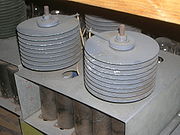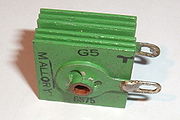
Selenium rectifier
Encyclopedia

Metal rectifier
A metal rectifier is an early type of semiconductor rectifier in which the semiconductor is copper oxide or selenium. They were used in power applications to convert alternating current to direct current in devices such as radios and battery chargers...
, invented in 1933. They were used to replace vacuum tube
Vacuum tube
In electronics, a vacuum tube, electron tube , or thermionic valve , reduced to simply "tube" or "valve" in everyday parlance, is a device that relies on the flow of electric current through a vacuum...
rectifier
Rectifier
A rectifier is an electrical device that converts alternating current , which periodically reverses direction, to direct current , which flows in only one direction. The process is known as rectification...
s in power supplies
Power supply
A power supply is a device that supplies electrical energy to one or more electric loads. The term is most commonly applied to devices that convert one form of electrical energy to another, though it may also refer to devices that convert another form of energy to electrical energy...
for electronic equipment, and in high current battery charger applications.
The photoelectric and rectifying properties of selenium were observed by C. E. Fitts around 1886 but practical rectifier devices were not manufactured routinely until the 1930s. Compared with the earlier copper oxide rectifier, the selenium cell could withstand higher voltage but at a lower current capacity per unit area.
Construction

Selenium
Selenium is a chemical element with atomic number 34, chemical symbol Se, and an atomic mass of 78.96. It is a nonmetal, whose properties are intermediate between those of adjacent chalcogen elements sulfur and tellurium...
rectifiers are made from stacks of square, or round, aluminum or steel
Steel
Steel is an alloy that consists mostly of iron and has a carbon content between 0.2% and 2.1% by weight, depending on the grade. Carbon is the most common alloying material for iron, but various other alloying elements are used, such as manganese, chromium, vanadium, and tungsten...
plated
Plating
Plating is a surface covering in which a metal is deposited on a conductive surface. Plating has been done for hundreds of years, but it is also critical for modern technology...
with about 1 μm of bismuth
Bismuth
Bismuth is a chemical element with symbol Bi and atomic number 83. Bismuth, a trivalent poor metal, chemically resembles arsenic and antimony. Elemental bismuth may occur naturally uncombined, although its sulfide and oxide form important commercial ores. The free element is 86% as dense as lead...
or nickel
Nickel
Nickel is a chemical element with the chemical symbol Ni and atomic number 28. It is a silvery-white lustrous metal with a slight golden tinge. Nickel belongs to the transition metals and is hard and ductile...
. A much thicker layer of selenium (50 to 60 μm) which has been doped with a halogen
Halogen
The halogens or halogen elements are a series of nonmetal elements from Group 17 IUPAC Style of the periodic table, comprising fluorine , chlorine , bromine , iodine , and astatine...
is deposited on top of the thin metal plating. The selenium is then converted into polycrystalline gray (hexagonal) form by annealing
Annealing (metallurgy)
Annealing, in metallurgy and materials science, is a heat treatment wherein a material is altered, causing changes in its properties such as strength and hardness. It is a process that produces conditions by heating to above the recrystallization temperature, maintaining a suitable temperature, and...
. Each plate is able to withstand about 20 volts in the reverse direction
Peak Inverse Voltage
The peak inverse voltage is either the specified maximum voltage that a diode rectifier can block, or, alternatively, the maximum that a rectifier needs to block in a given application.-In semiconductor diodes:...
. The metal squares, or disks, also serve as heat sink
Heat sink
A heat sink is a term for a component or assembly that transfers heat generated within a solid material to a fluid medium, such as air or a liquid. Examples of heat sinks are the heat exchangers used in refrigeration and air conditioning systems and the radiator in a car...
s in addition to providing a mounting place for the selenium disks. Plates can be stacked indefinitely to withstand higher voltages. Stacks of thousands of miniature selenium disks have been used as high voltage rectifiers in television set
Television set
A television set is a device that combines a tuner, display, and speakers for the purpose of viewing television. Television sets became a popular consumer product after the Second World War, using vacuum tubes and cathode ray tube displays...
s and photocopy machines.
Use
RadioReceiver (radio)
A radio receiver converts signals from a radio antenna to a usable form. It uses electronic filters to separate a wanted radio frequency signal from all other signals, the electronic amplifier increases the level suitable for further processing, and finally recovers the desired information through...
and television receivers used them from about 1947 to 1975 to provide up to a few hundred volts of plate voltage. Vacuum tube rectifiers had efficiencies of only 60% compared to the 85% of selenium rectifiers. Selenium rectifiers have no warm-up time unlike high vacuum rectifiers. Selenium rectifiers were replaced by silicon diodes with high efficiencies (close to 100% at high voltages). Selenium rectifiers had the capability to act as current limiters which can temporarily protect the rectifier during a short circuit and provide stable current for charging batteries.
Properties
A selenium rectifier is about the same size as copper oxide rectifiers, but much larger than a silicon or germanium diode. Selenium rectifiers have a long but not indefinite service life of 60,000 to 100,000 hours depending on rating and cooling. The rectifier can show some unforming of the rectifier characteristic after long storage. Each cell can withstand a reverse voltage around 25 volts, and has a forward voltage drop around 1 volt, which limits the efficiency at low voltages. Selenium rectifiers have an operating temperature limit of 130 C, and are not suitable for high-frequency circuits.Replacement
Selenium rectifiers had a shorter lifespan than desired. During catastrophic failure they produced significant quantities of malodorous and highly toxic fumes that let the repair technician know what the problem was. By far the most common failure mode was a progressive increase in forward resistance, increasing forward voltage drop and reducing the rectifier's efficiency. During the 1960s they began to be superseded bysilicon rectifiers which exhibited lower forward voltage drop
Voltage drop
Voltage drop is the reduction in voltage in the passive elements of an electrical circuit. Voltage drops across conductors, contacts, connectors and source internal resistances are undesired as they reduce the supplied voltage while voltage drops across loads and other electrical and electronic...
, lower cost, and higher
reliability. They are still manufactured for exact replacement purposes but are not designed into new equipment except for some automotive battery chargers.

